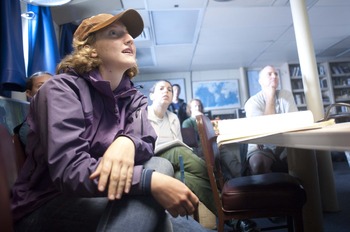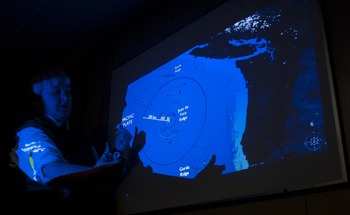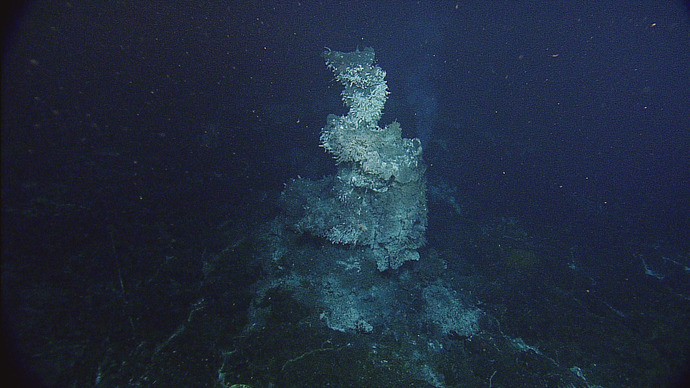We are about 10 hours into Jason dive J2-514 and have just had our first sighting of active hydrothermal vents! We are currently conducting a survey of the area around ASHES vent field with the purpose of collecting HD video and high-resolution digital stills that will be merged together to create a mosaic of the area. This active high-temperature hydrothermal system is located in the southwest region of the Axial caldera and contains chimneys reaching up to ~5 m high.
ASHES Hydrothermal Vent Field is a candidate location for a secondary node of the National Science Foundation's Ocean Observatories Initiative’s cabled observatory. This site will host a broadband and short-period seismometer array as well as a bottom pressure recorder and tilt meter. A suite of chemical and biological sensors will be located in and near vigorously venting chimneys and diffuse vent sites at ASHES to examine linkages among volcanic activity, seismicity, venting, and biological communities
Late in the evening of August 8 and into the morning of August 9, operations focused on conducting calibration of the shipboard navigation system to locate Jason when it is working on the seafloor. The system is called Ultrashort Baseline Navigation (USBL) which allows Jason’s position to be determined within a radius of ~ 5 m when it is at our working water depth of 1500 m. To begin this operation, an “elevator was first deployed carrying a transponder to the bottom that allows ranging on it from the surface. A transducer on the ship acoustically “talks” to the transponder on the elevator and the transponder acoustically “talks” back to the transducer at a given frequency. By knowing the velocity of sound in the water column and determining the shortest time return (most direct path), the location of the elevator can be well located.
When the elevator was deployed, a stack of weights was secured to its base causing the elevator to sink to the bottom, whereas a frame at the top of the elevator holding flotation spheres (with bright yellow hard hats) allows the platform to return to the surface…provided the weights are released successfully.
For nearly 6 hours the R/V Thompson conducted the navigation survey and at the end of the survey an acoustic signal was sent from the ship to a “burn wire” that was supposed to burn through, with the anticipated results that the weights would be dropped and the would return to the surface. However, we encountered a problem at dawn, when the elevator did not return to the surface after numerous “pings” on the burn wire to release the weights. Problem solving is an everyday occurrence at sea, and the Jason crew is masterful in this arena! Thus, Jason’s first deployment on Leg 2 became a search and rescue mission for the detained elevator. We easily located the platform and quickly assessed that its foot was stuck beneath a lobate lava flow the size of a large pillow. A gentle nudge from Jason’s manipulator arm was all that was needed, and the elevator was freed. It instantly began its ascent to the surface, 1.5 km above; mission accomplished!
Starting at 0900h this morning, we conducted a 5-hour RESON survey covering ASHES vent field and outward toward the center of the caldera. This survey obtained high-resolution bathymetric data that will aid in planning future surveys during this cruise, and in planning for placement of sensors that will be part of the high-power and bandwidth cabled observatory.
During the RESON survey, the science party met for an introduction to the hydrothermal vent systems and the geology at Axial Seamount. The students, excited to start collecting data now that they have their sea legs, began finalizing their plans for the research projects that they will be working on intensely while at sea for the next two weeks.




